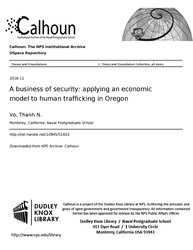File:A business of security- applying an economic model to human trafficking in Oregon (IA abusinessofsecur1094551632).pdf

Original file (1,275 × 1,650 pixels, file size: 674 KB, MIME type: application/pdf, 130 pages)
Captions
Captions
Summary[edit]
| A business of security: applying an economic model to human trafficking in Oregon
( |
||
|---|---|---|
| Author |
Vo, Thanh N. |
|
| Title |
A business of security: applying an economic model to human trafficking in Oregon |
|
| Publisher |
Monterey, California: Naval Postgraduate School |
|
| Description |
Human trafficking is the second-largest criminal industry in the world and has become the fastest-growing crime today, according to the U.S. Department of Health and Human Services. Many policies have attempted to reduce human trafficking through under-resourced initiatives and social services. This thesis explores whether applying an economic supply and demand model to human trafficking at the state level would reduce the prevalence of human trafficking. Using an economic supply and demand model, the research evaluates current literature and existing national and state policies within Oregon, analyzing weaknesses and gaps. The thesis presents policy analysis under a qualitative cost-benefit lens to assess economic model variables applied to state level policies. The conclusion is that existing anti-human trafficking policies in Oregon are lacking in instilling risks and costs associated with conducting the criminal behavior. Supply and demand actors in human trafficking are operating relatively unhindered in Oregon, which has led to a growth of the problem in the state. Thus, a three-pronged approach built around an applied economic supply and demand model is recommended to help reduce human trafficking in Oregon: reduce costs to victims, increase costs to suppliers, and increase costs to buyers. Subjects: human trafficking; trafficking in persons; modern slavery; sex trafficking; labor trafficking; Oregon; supply and demand; cost-benefit analysis |
|
| Language | English | |
| Publication date | December 2016 | |
| Current location |
IA Collections: navalpostgraduateschoollibrary; fedlink |
|
| Accession number |
abusinessofsecur1094551632 |
|
| Source | ||
| Permission (Reusing this file) |
This publication is a work of the U.S. Government as defined in Title 17, United States Code, Section 101. Copyright protection is not available for this work in the United States. | |
Licensing[edit]
| Public domainPublic domainfalsefalse |
This work is in the public domain in the United States because it is a work prepared by an officer or employee of the United States Government as part of that person’s official duties under the terms of Title 17, Chapter 1, Section 105 of the US Code.
Note: This only applies to original works of the Federal Government and not to the work of any individual U.S. state, territory, commonwealth, county, municipality, or any other subdivision. This template also does not apply to postage stamp designs published by the United States Postal Service since 1978. (See § 313.6(C)(1) of Compendium of U.S. Copyright Office Practices). It also does not apply to certain US coins; see The US Mint Terms of Use.
|
 | |
| This file has been identified as being free of known restrictions under copyright law, including all related and neighboring rights. | ||
https://creativecommons.org/publicdomain/mark/1.0/PDMCreative Commons Public Domain Mark 1.0falsefalse
File history
Click on a date/time to view the file as it appeared at that time.
| Date/Time | Thumbnail | Dimensions | User | Comment | |
|---|---|---|---|---|---|
| current | 20:04, 13 July 2020 |  | 1,275 × 1,650, 130 pages (674 KB) | Fæ (talk | contribs) | FEDLINK - United States Federal Collection abusinessofsecur1094551632 (User talk:Fæ/IA books#Fork8) (batch 1993-2020 #5045) |
You cannot overwrite this file.
File usage on Commons
The following page uses this file:
Metadata
This file contains additional information such as Exif metadata which may have been added by the digital camera, scanner, or software program used to create or digitize it. If the file has been modified from its original state, some details such as the timestamp may not fully reflect those of the original file. The timestamp is only as accurate as the clock in the camera, and it may be completely wrong.
| Short title |
|
|---|---|
| Author | sjhawtho |
| Software used | PScript5.dll Version 5.2.2 |
| File change date and time | 08:13, 26 January 2017 |
| Date and time of digitizing | 08:13, 26 January 2017 |
| Conversion program | Acrobat Distiller 11.0 (Windows) |
| Encrypted | no |
| Page size | 612 x 792 pts (letter) |
| Version of PDF format | 1.4 |

